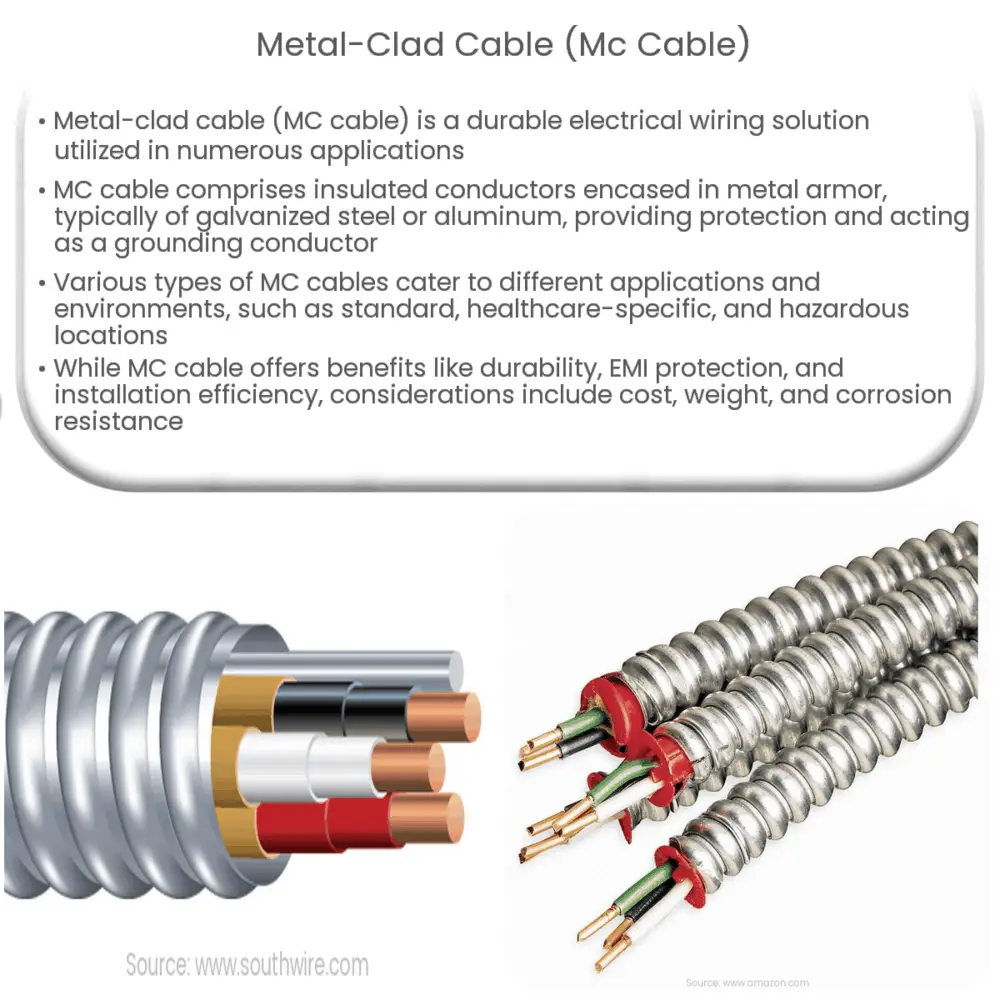Metal-clad cable (MC cable) is a durable, armored electrical wiring solution offering protection against mechanical damage and electromagnetic interference.

Metal-Clad Cable (MC Cable): An Introduction
Metal-clad cable, or MC cable, is a versatile and durable electrical wiring solution used in a wide range of applications. It offers excellent protection against mechanical damage and electromagnetic interference, making it a preferred choice for commercial and industrial installations. In this article, we will provide an overview of MC cable, its construction, types, and the benefits it offers over other wiring methods.
What is Metal-Clad Cable?
Metal-clad cable is a type of armored electrical cable designed to provide increased protection and durability in comparison to non-metallic sheathed cable (NM cable) or conduit systems. It consists of one or more insulated conductors enclosed in a flexible metal armor, typically made of galvanized steel or aluminum. The metal armor not only offers physical protection but also serves as an equipment grounding conductor, providing an additional layer of safety.
Construction of MC Cable
The construction of MC cable varies depending on the application and the specific type of cable. However, there are some common elements found in most MC cables:
- Conductors: MC cable features one or more insulated conductors, typically made of copper or aluminum. These conductors can be solid or stranded and are available in various sizes, depending on the current-carrying capacity required for a particular application.
- Insulation: The conductors in MC cable are surrounded by an insulating material, which can be made from various materials such as PVC, XLPE, or EPR. The insulation provides electrical isolation between the conductors and the surrounding metal armor.
- Metal Armor: The insulated conductors are enclosed in a flexible metal armor, which can be either interlocked or continuously welded. The metal armor provides mechanical protection and acts as an equipment grounding conductor.
- Outer Jacket: Some MC cables also feature an outer jacket, made from materials like PVC or polyethylene, for added protection against moisture, chemicals, and other environmental factors.
Types of Metal-Clad Cable
There are several types of MC cable available, each designed for specific applications and environments. Some of the most common types include:
- Type MC: The standard metal-clad cable, suitable for use in dry, damp, or wet locations. It can be installed in exposed or concealed work, and can be used in cable trays, raceways, or supported by messenger wires.
- Type MCI-A: Metal-clad cable with an integral grounding conductor, providing additional grounding without the need for a separate grounding wire. This type of MC cable is often used in healthcare facilities and other critical applications.
- Type MC-HL: A heavy-duty, hazardous location-rated MC cable, designed for use in environments with potential exposure to explosive gases or vapors. This type of cable is constructed with a gas/vapor-tight continuous aluminum sheath and is often used in refineries, chemical plants, and other high-risk areas.
Advantages of Metal-Clad Cable
There are several benefits associated with the use of metal-clad cable over other wiring methods, including:
- Durability: The metal armor of MC cable provides excellent mechanical protection, making it resistant to damage from impact, crushing, and abrasion. This makes it suitable for use in demanding environments, such as industrial facilities and commercial buildings.
- Electromagnetic Interference (EMI) Protection: The metal armor also serves as a shield against electromagnetic interference, reducing the potential for signal degradation and ensuring the reliable transmission of electrical power and data.
- Installation Efficiency: MC cable is easier and quicker to install than other wiring methods, such as conduit systems, as it does not require the use of separate grounding wires or additional fittings. This can result in significant time and cost savings during the installation process.
- Flexibility: Due to its flexible construction, MC cable can be easily routed around obstacles and through tight spaces, making it a convenient option for complex installations.
- Code Compliance: MC cable is widely accepted and meets the requirements of various electrical codes, including the National Electrical Code (NEC) in the United States.
Limitations and Considerations
While metal-clad cable offers many advantages, there are some limitations and factors to consider when selecting MC cable for a specific application:
- Cost: MC cable is generally more expensive than non-metallic sheathed cable (NM cable) due to its higher level of protection and durability. However, this cost may be offset by the reduced installation time and maintenance requirements.
- Weight: The metal armor adds weight to the cable, which may be a concern for some installations, particularly those involving long cable runs or overhead supports.
- Corrosion Resistance: While MC cable is designed to resist corrosion, certain environments with high levels of moisture, chemicals, or salt may require additional corrosion protection, such as PVC or other coatings.
Conclusion
Metal-clad cable is a versatile and durable wiring solution that provides excellent protection and performance in a wide range of applications. With various types of MC cable available, it is essential to select the appropriate cable for the specific environment and installation requirements. By understanding the advantages, limitations, and key considerations associated with MC cable, professionals can make informed decisions when selecting the best wiring method for their projects.

